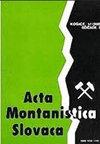基于RS和GIS方法、模糊逻辑和AHP的伊朗马赞德兰Neka流域岩溶带识别
IF 1.4
4区 地球科学
Q2 GEOSCIENCES, MULTIDISCIPLINARY
引用次数: 0
摘要
本研究的重点是使用RS&GIS方法,结合模糊逻辑集成和层次分析法(AHP),识别伊朗北部马赞德兰省Neka流域的部分区域和岩溶现象。在本研究中,从卫星和档案数据以及现场数据中提取了八个岩性因素,即与断裂线理的密度和距离、与排水道的密度和间距、地形坡度、降水和植被状况。然后将这些影响岩溶形成和发展的因素进行模糊处理,并用AHP方法进行加权,并与T-范数、T-范数(S-范数)和折衷算子相结合。使用ArcGIS、ENVI、RockWorks、IDRISI、Expert Choice和PCI Geomatica等软件对结果进行了处理,并在实地调查的基础上进行了评估。研究结果表明,大部分岩溶发育发生在上侏罗系的拉尔组。根据实地考察,模糊层集成的最佳和最合适的输出是使用0.9至0.95范围内的折衷算子。尽管由于植被状况和其他环境条件,陆地卫星8波段具有适当的提取线理的能力,但使用DEM也是必要的。本研究表明,利用新的遥感和GIS技术,结合模糊逻辑和AHP,提高了岩溶研究的准确性和速度,降低了成本。本文章由计算机程序翻译,如有差异,请以英文原文为准。
Identification of karstic zones using RS & GIS method, Fuzzy logic and AHP in Neka catchment, Mazandaran, Iran
This study focuses on identifying zones and karstic phenomena using the RS & GIS method along with Fuzzy logic integration and the Hierarchical Analysis Process (AHP) in part of Neka catchment in Mazandaran province in the north of Iran. In this research, eight lithological factors, density and distance from the fractured lineaments, density and distance from the drainages, topographic slope, precipitation and vegetation status, were extracted from satellite and archival data as well as field data. Then these factors which affect karst formation and development are fuzzy and are weighted by the AHP method and integrated with T-norm, T-conorm (S-norm) and Compromise Operators. The results were processed by using software such as ArcGIS, ENVI, RockWorks, IDRISI, Expert Choice and PCI Geomatica, which were evaluated based on fieldwork. The results of this study show that most karst developments occurred in Lar Formation with the upper Jurassic. According to field visits, the best and most appropriate output for fuzzy layers integration are the use of a compromise operator in the range of 0.9 to 0.95. In spite of the suitable ability of Landsat 8 bands to extract lineaments due to vegetation status and other environmental conditions, the use of DEM was also necessary. This study shows that the use of new remote sensing and GIS technology, combined with Fuzzy logic and AHP, increases accuracy and speed and reduces cost in karst studies.
求助全文
通过发布文献求助,成功后即可免费获取论文全文。
去求助
来源期刊

Acta Montanistica Slovaca
地学-地球科学综合
CiteScore
3.60
自引率
12.50%
发文量
60
审稿时长
30 weeks
期刊介绍:
Acta Montanistica Slovaca publishes high quality articles on basic and applied research in the following fields:
geology and geological survey;
mining;
Earth resources;
underground engineering and geotechnics;
mining mechanization, mining transport, deep hole drilling;
ecotechnology and mineralurgy;
process control, automation and applied informatics in raw materials extraction, utilization and processing;
other similar fields.
Acta Montanistica Slovaca is the only scientific journal of this kind in Central, Eastern and South Eastern Europe.
The submitted manuscripts should contribute significantly to the international literature, even if the focus can be regional. Manuscripts should cite the extant and relevant international literature, should clearly state what the wider contribution is (e.g. a novel discovery, application of a new technique or methodology, application of an existing methodology to a new problem), and should discuss the importance of the work in the international context.
 求助内容:
求助内容: 应助结果提醒方式:
应助结果提醒方式:


